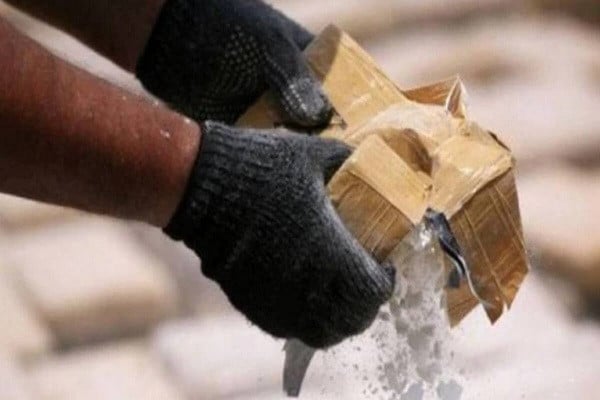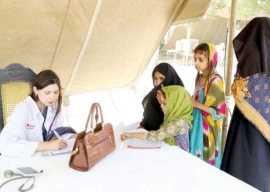
Even as the Pakistan government is planning to launch a countrywide survey soon to document the exact number of narcotic drug users, estimates suggest that there has been a slight decrease in their takers over the past decade.
Authorities say that rough estimates so far suggest that some 9 million people or slightly over 4% population of Pakistan are currently affected by different types of narcotics compared to approximately 6% of people in 2013.
Speaking to Anadolu Agency on the eve of the International Day of Drug Abuse and Illicit Trafficking, which is being observed on Sunday, Sabino Sikandar Jalal, a senior official of the Narcotics Control Ministry, said 60% of the drug users are categorized as "addicts" while remaining 40% are "occasional users”.
The current estimates, notwithstanding, are based on several small surveys and estimates as the country's anti-narcotics authorities have not carried out a proper survey to figure out the number of affected since 2013 due to "unavailability of budget."
Jalal said that the government in collaboration with the UN Office on Drugs and Crime (UNODC) is going to launch a countrywide survey to document the current number of drug users next month.
According to the last survey jointly conducted by the ministry and the UNODC, the number of opiate users was 6.7 million. Out of them 13% were women.
"Unavailability of latest data itself is a problem for us and other relevant authorities as we cannot take adequate steps to contain this menace and work for the rehabilitation of drug users," he said.
Sharing a similar view, Dr. Manzoor ul Haq, the adviser to UNODC Pakistan Office on Drug Demand Reduction and HIV/AIDS, told Anadolu Agency that only a new survey will show the exact situation. He said the increase or decrease in numbers at this stage is based on “assumption”.
Combined effort
Jalal said a "combined effort" of different law enforcement agencies, notably the Antinarcotics Force (ANF) and Pakistan Navy was behind the decline in the number of drug users in the country.
According to the 2013 survey, approximately 6% of the population, or 6.7 million people used controlled substances including the overdose of prescription drugs.
Pakistan is believed to be on the key route of heroin smuggling from neighboring Afghanistan, which produces 90% of the world's total opium.
Afghan opium is trafficked across the world, except for Latin America.
According to the UNODC, and the ministry, 40% of opium from poppy-rich Afghanistan is smuggled to Europe and Africa through sea and land routes via Pakistan.
The so-called "southern route" is used for drug smuggling to Africa and Europe via sea, whereas the traditional "northern route" or the "Balkan route"- is used to ship opium to Europe through land via Iran, Türkiye, and Russia.
Southwestern Balochistan province, which borders Afghanistan and Iran, is said to be a key transit point for drug trafficking between Pakistan and Afghanistan.
The route is also notorious for smuggling Iranian petroleum products.
Scores of small mobile laboratories have reportedly been operating on the lawless Pak-Afghan border for opium processing, according to UNODC.
Traditionally, chars and bhang (prepared from leaves of the cannabis plant) had long been the most-used drugs in Pakistan.
Bhang, as per a 2013 survey, was the most commonly used drug, with a prevalence of 3.6% of the population, equivalent to four million users nationwide.
Heroin became popular among drug users following the Russian invasion of Afghanistan in 1979, which led to a large-scale exodus of Afghan refugees to Pakistan.
An estimated 860,000 or 0.8% of the population were listed as regular heroin users and 320,000 (0.3%) were designated as opium users in the last survey.
Jalal said that Pakistan, like many other nations across the globe, has seen a surge in synthetic drugs, like "ice" and "ecstasy" in the last decade, mainly among youths.
Victim of drug trafficking
The Pakistani official said the world should see his country as a "victim" as it has "suffered a lot from drug smuggling" from Afghanistan.
He urged the international community to help Islamabad in its fight against drug smuggling "so that it could react and respond accordingly to curb this menace."
Pakistan was declared a poppy-free country by the UN in 2001, and since then Islamabad has successfully maintained the status.
Scores of rehabilitation and counseling centers for drug users are being run by the federal and provincial governments across the country, according to Jalal.
Nevertheless, he added, "it's not enough because the global relapse ratio is 60% to 70%".
Haq said the UNODC is running a host of support programs in schools and with the marginalized communities, to prevent drug use among children and youth.
"(UNODC has) also stepped up cross-border law enforcement and criminal justice cooperation and intelligence-sharing to disrupt transnational trafficking enterprises," he said.
To target the increasing drug trafficking via waterways, he said the organization is "strengthening container control and interdiction capacities at ports and sensitizing port authorities and commercial shipping companies to the related risks."

















COMMENTS
Comments are moderated and generally will be posted if they are on-topic and not abusive.
For more information, please see our Comments FAQ